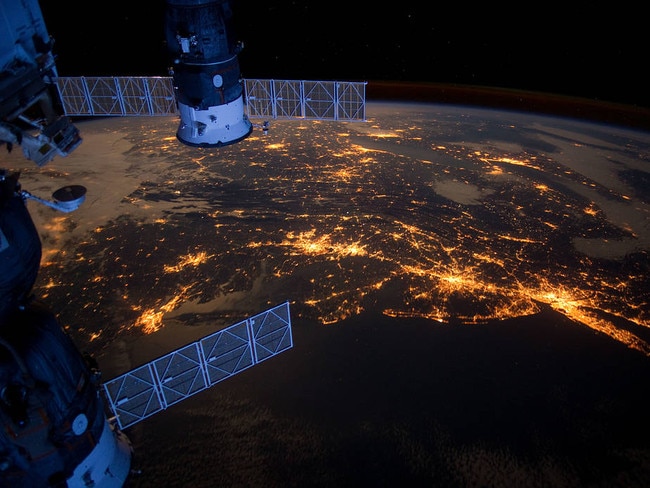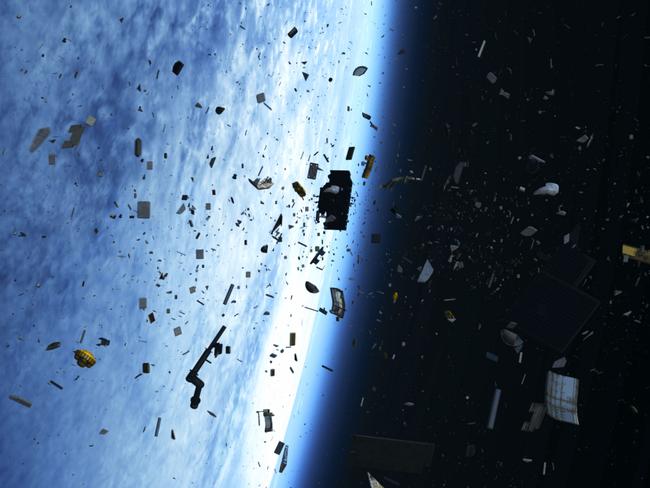For decades, the idea of extending Earthly wars into orbit has been taboo. The prospect of nuclear-armed satellites ready to drop on our heads was simply too terrifying. Then there was the implications of all the debris …
Now, as more and more nations gain the ability to loft satellites into space, the old treaties between the United States and Russia have become increasingly irrelevant.
India. Pakistan. North Korea. All have recently joined the space race.
China, meanwhile, has been actively testing missiles capable of destroying satellites — the most recent being in January this year.
The implications are terrifying.
There’s already plenty of deadly space junk hurtling about in orbit above our heads.
A simple fleck of paint — travelling at immense speeds — was enough to deeply crater a Space Shuttle’s reinforced glass windscreen.
Scale that up to clouds of jagged wreckage from an intensely-fought space war, and some analysts fear we may lock ourselves on Earth’s surface forever.
It would simply become too risky to send a vehicle — manned or otherwise — into the deadly orbital crossfire, possibly for centuries to come.
SPACE FORCE ONE
Trump’s immensely proud of his ‘Space Force’ name. He came up with it himself.
Earlier this year, he ordered the Pentagon to establish it as the sixth arm of the United States’ military.
“We are going to have the air force and we’re going to have the ‘Space Force’. Separate but equal. It is going to be something. So important.”
It’s the most open sign that the long-standing Outer Space Treaty, which bans weapons in space and restricts access to the Moon and Solar System to peaceful purposes, has been abandoned.
A new Space Council was been charged with making Trump’s vision a reality. It’s being run by Vice President Mike Pence. And now Pence has delivered: he's outlined plans to have the sixth arm of the US military up and running by 2020.
“The time has come to write the next great chapter in the history of our armed forces, to prepare for the next battlefield where America’s best and bravest will be called to deter and defeat a new generation of threats to our people, to our nation," he said. “The time has come to establish the United States Space Force.”
Trump had already outlined why. “It is not enough to merely have an American presence in space,” he said. “We must have American dominance in space. I am instructing my administration to embrace the budding commercial space industry.
"We are modernising out-of-date space regulations. They’re way out of date. They haven’t been changed in many, many years. And today we’re taking one more step to unleash the power of American ingenuity.”
RELATED: How NASA hopes to defend Earth from deadly asteroids
Mr Pence said an independent Space Force was essential to counter Russia and China, which are “aggressively” working toward anti-satellite capabilities.“China and Russia have been conducting highly sophisticated on-orbit activities that could enable them to manoeuvre their satellites into close proximity of ours, posing unprecedented new dangers to our space systems,” he said.

Earlier this year, US air force Chief of Staff General David Goldfein told the Air Warfare Symposium and Technology Exposition in Orlando, Florida, that he felt war in space was inevitable.
“I believe we’re going to be fighting from space in a matter of years,” Goldfein said. “And we are the service that must lead joint warfighting in this new contested domain. This is what the nation demands.
“[It’s] time for us as a service, regardless of specialty badge, to embrace space superiority with the same passion and sense of ownership as we apply to air superiority today. I look forward to discussing how we can leverage new technology and new ways of networking multi-domain sensors and resilient communications to bring more lethality to the fight."
ORBITAL BATTLEFIELD
“All actors will increasingly have access to space-derived information services, such as imagery, weather, communications, and positioning, navigation, and timing for intelligence, military, scientific, or business purposes,” US Director of National Intelligence Daniel Coats said in a US Senate Threat Assessment presentation earlier this year.
“As if we don’t have enough threats here on Earth, we need to look to the heavens — threats in space”.
EXPLORE MORE: Here’s what the US sees as the future of air combat
Space is not as empty as you may think.
In fact, the area around Earth is getting somewhat crowded.
At the moment, there are roughly 1300 active satellites spinning about our planet. Several thousand more ‘dead’ ones are still in place.
They give us weather forecasts. They give us GPS coordinates. They give us internet and telephone communications. They explore our universe.

But much of their use is already military: precision navigation, secure communications, threat detection, surveillance … All are integral components for modern warfighting.
Which is why eliminating the enemy’s assets — while protecting your own — is so obviously desirable.
There are many ways to disable a satellite. Clouds of paint or corrosive substances could disable sensors and solar panels. Electromagnetic pulses could fry electronics. Lasers could do all of the above.
But simply smashing them to pieces with a bullet appears to remain the preferred option of the world’s militaries.
KINETIC SPACE KILLS
In March, US Defense Intelligence Agency director Lieutenant General Robert Ashley Jr. told the US Senate that Russia and China were developing weapons for use in a space war.
It was no revelation.
Russia has been boasting it is developing a ground-based laser capable of melting satellites in orbit. And China has been actively testing satellite kill missiles in recent years.
The objective is to eradicate any spy satellites observing the territories they lay claim to, and disrupt any opposing force’s communication and navigation systems.
To achieve this goal, China has been experimenting with high-speed, missile-launched kinetic kill vehicles. Essentially, big guided lumps of metal that smash their target into smithereens.
It’s a worst-case scenario for the future of space travel.
The impact and speed of these weapons create large clouds of debris. These can be blasted into higher orbits, remaining there for decades — if not centuries.

In 2007, China deliberately destroyed one of its own redundant satellites in an orbit of 865km. This one test created a hail of some 3000 high-velocity fragments that are still being tracked because of their destructive potential. It’s estimated some 150,000 smaller pieces are still hurtling about in space, unseen.
In April 2011, the International Space Station took precautionary measures when some of these fragments passed within 6km.
China repeated just such a satellite kill mission in January.
It’s easy to see how the prospect of a full-scale ‘space war’ could simply close the use of space to humanity for centuries to come.
HEAVENLY GATES
The most deadly battlefield probably won’t be Korea, Taiwan or the South China Sea. Even Eastern Europe, in such a scenario, would eventually be seen as little more than a side show.
The most intense battlefield will be above all our heads. Above the skies.
And the bullets will remain flying for thousands of years.

It has been calculated that there are already more than 600,000 piece of space junk ranging in size from 1cm to 10cm cannoning about in orbit. Roughly one satellite is destroyed each year (sometimes deliberately), adding to this deadly cloud.
It’s of such great concern already that major international efforts are underway to find ways to ‘clean up’ space junk. Australia is playing a key role in identifying and tracking deadly debris.
It's predicted that within 20 years space may become too full of rubbish to operate critical satellites.https://t.co/c75JPyC7P2
— Australian Academy of Science (@Science_Academy) June 19, 2018
At the moment, the Low Earth Orbits (LEOs) used by the International Space Station and other manned space flights are relatively safe. Fragments from satellites this low tend to shoot back to Earth. Those that remain are dangerous, but are gradually drawn down by gravity and the minuscule drag of the outermost fringes of our atmosphere.
Further out are Geosynchronous Oribits (GEOs), where satellites are not subject to this drag. Here, debris are still gently buffeted by the gravity of the Earth and Moon. But it could take millennia before any debris eventually re-enters the atmosphere.
And while it’s swirling around up there, each and every piece is a speeding bullet more than capable of penetrating even the best protected manned space module.
And this presents a problem.
A runaway chain reaction.
The pieces of one destroyed satellite can go on to destroy several more. And each of those will send out fresh debris, that destroy yet more. And so on.
It’s called the Kessler Syndrome.
And it could close our access to space.
* Video clips from US Air Force, Raytheon promotional material.
